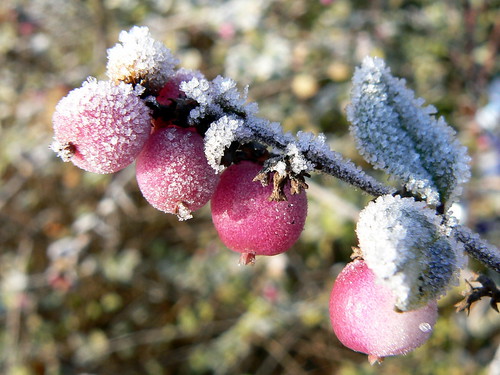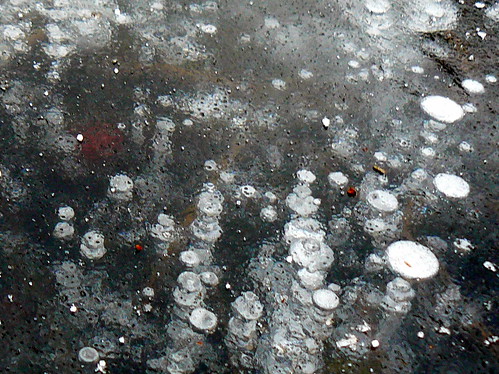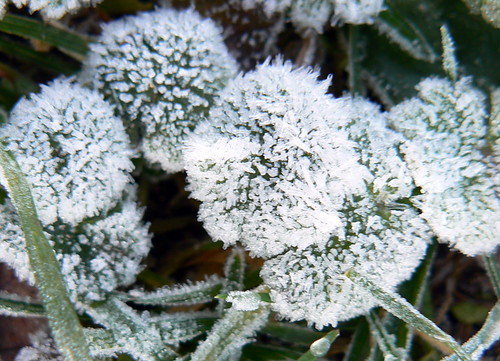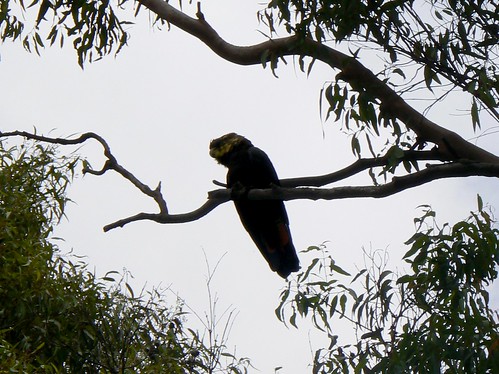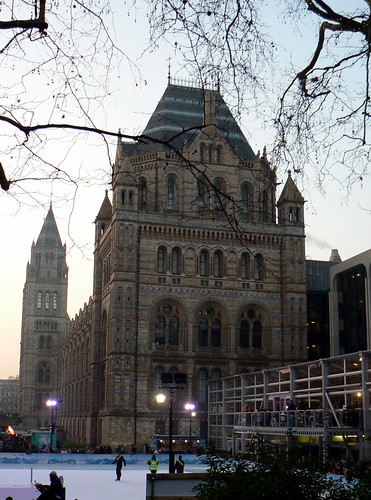Sounds a little disciple-like, doesn't it? Mind you, "fan" isn't much better.
Anyway, you'll see on the top left of this page a little widget that allows blog readers to indicate (either anonymously or using their online name) they're following the blog. The idea is that by showing that this is a screamingly popular site (not that it is, but I do have plans to rule the world), I can get scads more readers, which would be jolly. It also allows you to be notified of updates to any Blogspot blog you're following.
So please, if you like this blog, click on the widget and let the cosmos know! (I am sure it will be fascinated.)
Cheers,
Margaret
Sunday, January 11, 2009
Saturday, January 10, 2009
Plants on (in!) Ice.
I've come home from freezing temperatures to days of over 30C, and over the last few weeks there's been little rain here. So I spent early Wednesday morning trying to cheer up a few of my more vulnerable plants with some deep watering. (Of course, as is in the nature of gardening, we had a thunderstorm that afternoon and everything got a good drink the old-fashioned way.)
A little reading (see below) on the subject has been very enlightening.
In order for plants to tolerate freezing, they must first undergo cold acclimation. A plant that has not been exposed to non-freezing cold might die at around -5C, while the same species that has been cold acclimatised can survive to -30C. This sort of temperature trigger is common in plants. Temperature changes induce flowering and seed production, and winter dormancy--as does changing day length.
The damage caused to plants by freezing occurs in cell membranes, with ice crystals forming in the spaces between the plant cells. This draws fluid from within the cells to these intercellular spaces. As a result, the cells become dehydrated, and this in turn damages the membranes themselves. One form of this damage is to the lipids--fat-soluble molecules--which help provide cell membrane structure. Cells can also rupture as a result of ice forming adhesions between cell walls and membranes. Further injury to the plant is possibly caused by protein denaturation, where the complex three-dimensional folding structure of a protein molecule is disrupted.
So how do some plants survive freezing temperatures and avoid this damage, and how does cold acclimation facilitate this?
It's been established that cold acclimation can change gene expression--that is, it triggers the replication of particular genes within the plant and thus the production of specific enzymes (proteins that act as a catalyst in a chemical reaction). A range of genes examined have various effects: some encode for a protein that alters lipid composition while others stabilise proteins against freeze-induced denaturation. There are many other genes expressed as a result of cold acclimation whose roles are not yet determined. In addition, low temperatures trigger a signal transduction cascade--essentially a domino effect of proteins acting upon each other within a cell. Calcium pours into the cell cytoplasm, triggering processes that induce gene expression.
None of this is going to have much import in my garden, whose main duty will be to stay alive during the increasing drought and heat of climate change. Still, looking at photos of chilly plants is a fine way to cool down!
Reference: Thomashow, M.F. 1999. Plant Cold Acclimation: Freezing Tolerance Genes and Regulatory Mechanisms. Annu. Rev. Plant Physiol. Plant Mol. Biol. 50:571–99. LINK.
The contrast between Here, in summer, and There, in winter, demonstrates the sort of extremes plants must tolerate in different ecosystems. I was fascinated by the sight in the Netherlands of plants coated in frost, and indeed, frozen in solid ice.
My mother-in-law's pond. Embedded in the ice are water lilies, and
beneath, just visible, are goldfish, content in the knowledge
that water expands when frozen and insulates them from
the air temperatures above.
Now, if you're from somewhere that has winters like these, you probably think I'm a parochial git for being so entranced by the novelty of plants coping with a serious winter. But from my balmy (ahem.... meteorologically speaking), temperate Sydney perspective, it's simply extraordinary.beneath, just visible, are goldfish, content in the knowledge
that water expands when frozen and insulates them from
the air temperatures above.
A little reading (see below) on the subject has been very enlightening.
In order for plants to tolerate freezing, they must first undergo cold acclimation. A plant that has not been exposed to non-freezing cold might die at around -5C, while the same species that has been cold acclimatised can survive to -30C. This sort of temperature trigger is common in plants. Temperature changes induce flowering and seed production, and winter dormancy--as does changing day length.
The damage caused to plants by freezing occurs in cell membranes, with ice crystals forming in the spaces between the plant cells. This draws fluid from within the cells to these intercellular spaces. As a result, the cells become dehydrated, and this in turn damages the membranes themselves. One form of this damage is to the lipids--fat-soluble molecules--which help provide cell membrane structure. Cells can also rupture as a result of ice forming adhesions between cell walls and membranes. Further injury to the plant is possibly caused by protein denaturation, where the complex three-dimensional folding structure of a protein molecule is disrupted.
So how do some plants survive freezing temperatures and avoid this damage, and how does cold acclimation facilitate this?
It's been established that cold acclimation can change gene expression--that is, it triggers the replication of particular genes within the plant and thus the production of specific enzymes (proteins that act as a catalyst in a chemical reaction). A range of genes examined have various effects: some encode for a protein that alters lipid composition while others stabilise proteins against freeze-induced denaturation. There are many other genes expressed as a result of cold acclimation whose roles are not yet determined. In addition, low temperatures trigger a signal transduction cascade--essentially a domino effect of proteins acting upon each other within a cell. Calcium pours into the cell cytoplasm, triggering processes that induce gene expression.
None of this is going to have much import in my garden, whose main duty will be to stay alive during the increasing drought and heat of climate change. Still, looking at photos of chilly plants is a fine way to cool down!
A clover plant by the side of the road in Belgium,
just before the snow dumped on it.
just before the snow dumped on it.
Reference: Thomashow, M.F. 1999. Plant Cold Acclimation: Freezing Tolerance Genes and Regulatory Mechanisms. Annu. Rev. Plant Physiol. Plant Mol. Biol. 50:571–99. LINK.
Friday, January 09, 2009
Calyptorhynchus lathami -- Glossy Black-Cockatoos
I just took these shots (not the best, but the birds were high up!) of Glossy Black-Cockatoos in our garden. They were a family with a squawking baby, feeding on the fruits of an Allocasuarina, their preferred diet.
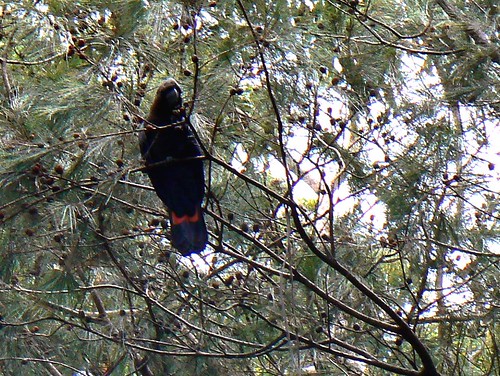

Calyptorhynchus lathami is variously listed as threatened and vulnerable, in large measure because its Allocasuarina habitat has been substantially reduced.
The female has irregular yellow blotches on her head and a red tail panels, while the male lacks the yellow and has less red on the tail. According to Simpson and Day's Field Guide to the Birds of Australia, the species can be both nomadic and sedentary, and their description of the call, "soft, wailing 'tarr-red'," certainly seems accurate.
I've planted a number of Allocasuarina in the garden to supplement the mature specimens already here, so I hope the Glossy Blacks will long find our home a good haven and she-oak restaurant.
The female has irregular yellow blotches on her head and a red tail panels, while the male lacks the yellow and has less red on the tail. According to Simpson and Day's Field Guide to the Birds of Australia, the species can be both nomadic and sedentary, and their description of the call, "soft, wailing 'tarr-red'," certainly seems accurate.
I've planted a number of Allocasuarina in the garden to supplement the mature specimens already here, so I hope the Glossy Blacks will long find our home a good haven and she-oak restaurant.
Tuesday, January 06, 2009
Darwin's Big Idea: a pilgrimage.

We've just returned from a few weeks in Europe, visiting family in the Netherlands and London, and pottering about in Belgium and France. A highlight of the trip was a visit with my sister-in-law, Mirjam, to the Natural History Museum in London. It is hosting a magnificent and comprehensive exhibition on the life and work of Charles Darwin, Darwin: Big Idea, Big Exhibition, celebrating the 200th anniversary of his birth and the 150th of the publication of “The Origin of Species”.
It is just superb, with exhibits of his original notes and letters, of specimens he collected on the Beagle, of some of his extensive beetle collection, and masses of fossils and skeletons demonstrating the changes over time of various lineages. Of particular delight is a selection of herbarium sheets with some of his plant specimens. The NSW Herbarium has plenty of Banks and Solander's specimens which are worthy of adoration, but these are especially significant, as are Hookes' and Huxley's encouraging letters to Darwin when he was so apprehensive about the consequences of publishing “The Origin”.
There are videos discussing exactly what a theory is, and another explaining the processes of natural and sexual selection. A reconstruction of his study in Down House—where he wrote his books—is so intimate, you expect to see him walk in and start examining his specimens. One very touching exhibit is a drawing made by one of his daughters. Apparently, he was always concerned to reuse paper when possible, and he gave her this sheet—on the back of which was a page of his first handwritten draft of “The Origin”.
Happily, the exhibition was absolutely packed with visitors. It is well constructed to be accessible to people with little knowledge of biology or evolution, but sufficiently in-depth to satisfy the obsessive, geeky biologist!
And yes, I bought the t-shirt and the fridge magnet! The magnet is a rendering of the image in one of his notebooks, depicting his first conception of the "tree of life".

The exhibition goes till 19 April 2009, so if you are even faintly in the vicinity of London before then, attendance is compulsory.
Subscribe to:
Posts (Atom)
